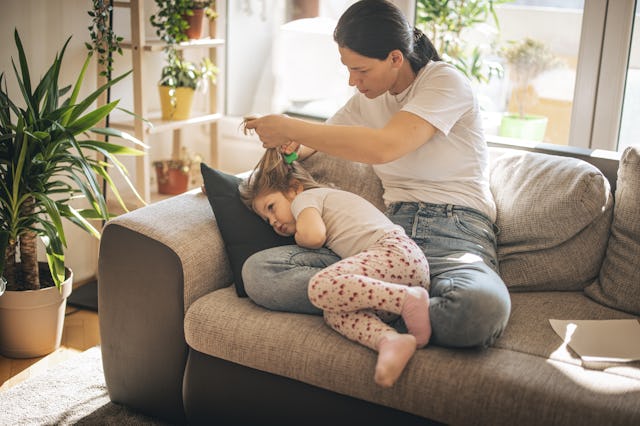Kids With Lice Should Stay In School According To New Guidance
The American Academy of Pediatrics say that lice are relatively harmless, while missing school and being singled out is not.

It’s hard not to freak out when your kids get head lice. Catching a glimpse of an actual live bug scurrying through your kid’s hair is never a good moment, and your first impulse might be to carefully run caution tape around your house and then burn everything to the ground.
But new guidance on head lice and nits (their eggs), released this week by the American Academy of Pediatrics (AAP), wants everyone, including schools and parents, to calm down a bit about lice — and to do so for the sake of our kids.
The new guidance states that schools should stop sending kids home and parents should stop keeping kids home from school because of lice.
While this update — the first one regarding lice protocol issued by the AAP since 2015 — might seem both shocking and super gross at first, it’s actually based in science and tailored to the best interests of children, even if it seems counterintuitive at first.
Read more: Calm The Hell Down, It’s Just Lice
First and foremost, the guidance stresses that much of the lice protocol of the past is both out of date and not in line with scientific findings. Instead, it’s in line with stigma and misconception, the AAP believes. For example, lice is not correlated in any way with poor hygiene and it is not a significant health hazard, even if it is something you definitely want to treat quickly.
The bigger hazard than lice, the AAP says, is kids missing school and being called out among their classmates.
“School exclusion of children or adolescents with nits alone would have resulted in many of these children or adolescents missing school unnecessarily," the AAP states. "In addition, head lice infestations have been shown to have low contagion in classrooms."
Changes have to be made by both parents and school systems, many of which still have outdated zero-nit policies that cause days and sometimes weeks of absences for kids.
“No healthy child or adolescent should be excluded from school or allowed to miss school time because of head lice or nits," the guidance states. "Medical providers should educate school communities that no-nit policies for return to school should be abandoned, because such policies would have negative consequences for children’s or adolescents’ academic progress, may violate their civil rights, and stigmatize head lice as a public health hazard."
The current lice policies and attitudes can also cause kids psychological harm, the guidance warns.
“It is important for medical providers to educate and reassure affected individuals and caregivers that head lice are neither a health hazard nor a sign of poor hygiene and are not responsible for the spread of any disease,” the AAP writes. “Despite this knowledge, there is significant stigma resulting from head lice infestations in high-income countries, resulting in children and adolescents being ostracized from their schools, friends, and other social events. Head lice can be psychologically stressful to the affected individual.”
Pediatrician Shelly Vaziri Flais, author of the AAP’s Caring For Your School-Aged Child, tells Scary Mommy that guidelines like these change over time as researchers learn more about the world around us.
“It’s like when our smartphones get updated,” she explains. “As societies and families and schools, we get into their patterns of thoughts and behaviors, and the AAP brings everyone up to speed on what we know and what is effective. As a pediatrician and a mom who’s been through it, I can tell you that this is a common sense and advanced approach.”
So, what should you do if your kid has lice? The single best step is to call your pediatrician and find a solution that is right for your kid and your circumstances. The recommended treatment could be a prescription, an over-the-counter treatment, or nit combing.
“While it is psychologically stressful, don’t burn your house down,” she jokes. “Despite our response, [head lice] just doesn’t pose a serious medical threat to our kids. The harm to the child comes from being excluded. It comes from missing school.”
Dr. Flais’ best advice is to stay away from Dr. Google and give your pediatrician a call right out of the gate.
“Call your pediatrician, it’s far superior to Google,” she explains. “Online, you’ll get marketed, targeted posts with expensive nit-combing services, you’ll get home remedies, and we don’t want patients to waste time or resources on things that don’t work or that aren’t economical. We don’t want parents to get frustrated with solutions that don’t work or for kids to miss that much school.”
Flais also stresses that lice, unlike fleas, can’t jump and like to stay close to the scalp, meaning that they don’t transfer easily at elementary school unless kids are sharing hats, putting their heads together, or placing their heads on the same piece of upholstered furniture.
She also explained that the pandemic and our national response to COVID-19 had informed and colored this guidance. It’s so important to keep kids with COVID home to minimize infection and spread — but with lice, it’s simply not a public health emergency that requires quarantine.
“I think [COVID] skewed our psychology over what is and is not an emergency,” she says. “I’m talking to families with kindergarteners and first and second graders. We have kids who have been home for two years, families who skipped preschool, and these kiddos don’t have the socialization and routines that other kids do. I’m seeing a lot of adjustment issues. When it came to the hospitals being overwhelmed, it made sense for kids to stay home. But for something like head lice, let’s get some normalcy for these kids. Kids do best with structure and a rhythm and that’s why the timing of this update is good.”